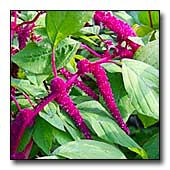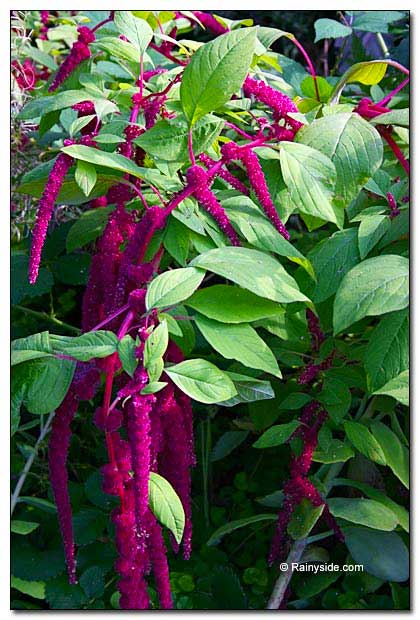Amaranthus caudatus
LOVE-LIES-BLEEDING, TASSEL FLOWER
Synonyms: A. edulis, A. leucocarpus, A mantegazzianus
Family: Amaranthaceae
Pronounced: am-ah-RAN-thus kaw-DAW-tus

Quick Jumps
Growing Guide
Rainy Side Notes
GROWING GUIDE

Origin:
Africa, India, Peru.
Plant Group:
Annual.
Hardiness:
Sunset zones: 1-24, H1, H2.
USDA zones: All (when grown as an annual); 10-11 (when grown as a short-lived perennial).
Heat zones: 12-1.
Mature size:
Height: 3-5 feet (1-1.5 m), taller in shade at the expense of flower production.
Width: 18-30 inches (45-75 cm).
Flowering period:
Summer to early autumn.
Flowering attributes:
Blood-red flowers cover drooping spikes up to 1 foot long, growing out from the leaf axils.
Leaf attributes:
Ovate, light green leaves.
Light:
Full sun to partial shade.
Soil:
Average, infertile, moist soil.
Propagation Methods:
Maritime Pacific Northwest soil warms up slowly in spring. These seeds germinate best at temperatures above 70°F (21°C). To get an early start, sow seed indoors, cover seed lightly, as it needs light to germinate, and place in a plastic bag with temperatures between 70-85°F (21-29°C). Germination occurs within 6-15 days.
Sow seed directly in the garden after soil warms up to at least 55°F (12°C). When the ground is warm, germination is rapid.
Pests and Diseases:
Problems with root rot, fungal leaf spot, or aphids may occur.
Rainy Side Notes
I don't know if its common name, love lies bleeding, was the inspiration when Bernie Taupin wrote the lyrics for Funeral for a Friend/Love Lies Bleeding. When my generation hears the name, it's a step back in time to the 70's, an era when a concert with Elton John meant a night of mad-hatter-like costumes and oversized glasses, while he played the piano and sang out Taupin's desires. Perhaps the flamboyant flowers of the Amaranthus and name was predestined to become an Elton John/Bernie Taupin song.
All speculation aside, even with a bloody common name, this species is ornamental as well as edible. When raising it to eat, grow it on infertile soil. On nitrogen-rich soil, the plant accumulates nitrates in the leaves, which may cause stomach cancers and blue babies disease. Fortunately, Amaranthus grows adequately on infertile, sandy soil. Give the plant well-drained soil, since it is susceptible to root rot.
The genus name, Amaranthus, comes from the Greek word amarantos, meaning unfading, referring to its long lasting flowers. Its epithat, caudatus, means with a tail, referring to its long inflorescence.
Use the young leaves raw in salads, or cooked like spinach. Seeds can be eaten raw. As cut flowers, they can be used fresh in bouquets or dried. When dried, the flowers retain most of their color. Cut for fresh bouquets when ¾ of the flowers on the stem are open. The flowers will stay fresh in water for 7-10 days. Pick for dried use when seed begins to set and the flowers are firm to the touch. If picked before this stage the flowers will shrivel. Hang stems upside down to dry for at least ten days. The higher the heat while they dry, the better the flowers retain their color.
These are superb plants for hanging baskets.
Water your plants deeply, but infrequently. Use a soaker hose or drip system to irrigate, since overhead watering can cause the stems to break or the plant to fall over. Stake your plants, if you must water overhead.
Debbie Teashon
Photographed in author's garden.

Gardening for the Homebrewer: Grow and Process Plants for Making Beer, Wine, Gruit, Cider, Perry, and More
By co-authors Debbie Teashon (Rainy Side Gardeners) and Wendy Tweton
Copyright Notice | Home | Search | Annuals

